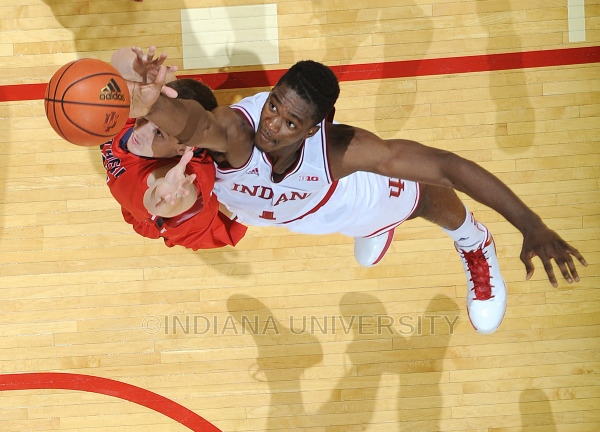Rebounding Work Key for Indiana When Facing a Zone
Posted by Deepak Jayanti (@dee_b1g) on November 22nd, 2013After watching two weeks of the regular season and reading at least a month of preseason coverage, it is a well known fact that the Hoosiers may not have a consistent shooting threat from beyond the arc. Even though Yogi Ferrell has improved his long-range shot in the early-going (41%), Will Sheehey has been ice cold (24%) and without Jordan Hulls and Christian Watford, there are few other options. Syracuse laid out a recipe for success against the Hoosiers during the NCAA Tournament last season, which is that Indiana struggles against an athletic zone. That specific game, combined with ongoing question marks about their long-range shooting, provides enough reason for opposing coaches to to use the strategy. But while a zone may serve to slow Indiana’s offense down, the Hoosiers will have a huge rebounding edge with their front line of Noah Vonleh and Troy Williams. For instance, Washington utilized a zone against the Hoosiers last night and it worked in one sense because Tom Crean’s squad shot just 3-of-14 from beyond the arc. However, the zone exposed the offensive glass and the Hoosiers nearly doubled up the Huskies on the boards, 47-27. This tradeoff should continue throughout the season because teams are likely to zone the Hoosiers, and Vonleh and Williams relentlessly attack the glass.
Vonleh was described as a “pogo stick” by the announcers during the game and it may be a fair description because he is proving his rebounding strength, especially on the offensive end. The freshman forward is averaging 12.5 RPG this season and grabbed four offensive boards against Washington. He has excellent footwork in the paint and uses his body to effectively to block out his defender. The Huskies did a good job of trapping Ferrell and Jeremy Hollowell in the high post, forcing them to shoot at the end of the shot clock, but Vonleh was in the right place at the right time to retrieve the caroms. In general, a zone defense leaves the offensive glass open because three defenders crowd the players around the free throw line, which leaves lanes to attack the glass. Even the mighty and athletic Syracuse zone has issues covering the offensive glass because the baseline or the weak side of the basket is usually wide open.
Vonleh and Williams will definitely take advantage of this glitch. Vonleh is already averaging a double-double (14.8 PPG and 12.5 RPG), and he’ll have a tougher time against Big Ten competition, but it is safe to say after the first two weeks he will provide the Hoosiers a panacea against gimmicky zone defenses. There were several possessions against Washington when Williams came flying off the baseline to tip in a shot or draw a foul, and his location of the gaps will also help. These two players will help ease the pain but an effective zone with decent coverage in the paint will still serve to make the Hoosiers uncomfortable. Putting aside the possessions which resulted in those easy putbacks from offensive rebounds, Crean’s team struggled at times against it. The arc of Indiana’s success this season could ultimately depend on these two factors: whether the Hoosiers can find another consistent long-range threat; and whether the two freshman big men can continue to feast on the offensive boards.












































